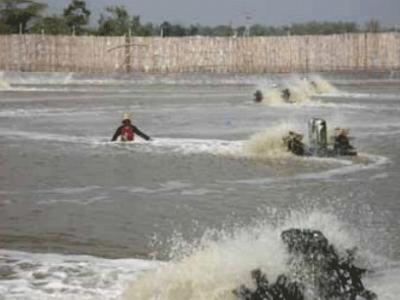Successful production in semi-biofloc in Indonesia
The Aquaculture Experience Farm in Java operated a hybrid system, based on a careful balance between autotrophic and heterotrophic organisms
 Low cost Medium Shear Extruder for pet food and aquafeed
Low cost Medium Shear Extruder for pet food and aquafeed The single screw extruder has been the heartbeat of dry pet food and aquatic feed for over 50 years. Today, the single screw extruder still is the choice
 A Case Study on Feed Management to Improving Production
A Case Study on Feed Management to Improving Production A Case Study on Feed Management to Improving Production and Economic Returns for the Semi-Intensive Pond Production of Litopenaeus vannamei
 Harmful Effects on Toxin Dinoflagellates in Shrimp Culture Ponds
Harmful Effects on Toxin Dinoflagellates in Shrimp Culture Ponds Phytoplankton are the key food item in both aquaculture and mariculture. Both systems are utilizing phytoplankton as food for the animals being farmed.
 Essential Silica management to grow diatoms for aquaculture
Essential Silica management to grow diatoms for aquaculture We have been doing a lot of work recently talking with aquaculture farmers about their pond water and how they manage the algae populations in the ponds
 'Big Picture' Connects Shrimp Disease and Inbreeding
'Big Picture' Connects Shrimp Disease and Inbreeding Disease problems on shrimp farms may be partly driven by an interaction between management practices that cause inbreeding in small hatcheries
 XTRACT® Shrimp improves performance and resistance to disease in Pacific white shrimps
XTRACT® Shrimp improves performance and resistance to disease in Pacific white shrimps The major challenges in shrimp farming include optimizing parameters of productive performance such as the growth rate, final weight, and feed efficiency
 Can Natural Strategies Effectively Combat EMS?
Can Natural Strategies Effectively Combat EMS? Each year the shrimp industry suffers losses of more than US$1 billion due to early mortality syndrome or acute hepatopancreatic necrosis (EMS/AHPND)
Feed additives may help to reduce the impact of early mortality syndrome on shrimp stocks, according to a report from Minh Phu AquaMekong Shrimp Vet Laboratory
 Water Quality Parameter Analysis for the Feasibility of Shrimp Culture
Water Quality Parameter Analysis for the Feasibility of Shrimp Culture Shrimp culture in ponds has been expanded to be a bio-food industry proved to yield foreign exchange and provide job opportunities besides animal protein source
 Attractability of Probiotic-Coated Shrimp Feed
Attractability of Probiotic-Coated Shrimp Feed The marine shrimp, having poor sight, need to recognise their environment by other senses, i.e. tactile, gustatory and olfactory.
The pompano are reared in a clearwater system, and the shrimp are cultured in a heterotrophic system maintained by inputs of biofloc from an external bioreactor
 Functional Feed Additives to Prevent Disease in Farmed Shrimp
Functional Feed Additives to Prevent Disease in Farmed Shrimp Shrimp producers must consider genetics, seed stock quality, husbandry procedures and healthy nutrition as the major tools to control disease
 How to Control Microsporidian Parasites in Shrimp Farms
How to Control Microsporidian Parasites in Shrimp Farms Enterocytozoon hepatopenaei (EHP) a microsporidian parasite that has been widely found in Asia and other parts of the world, is impacting aquaculture production
 Organic Acid Supplements in Tiger Shrimp Diets
Organic Acid Supplements in Tiger Shrimp Diets The threat of disease in the aquaculture industry, coupled with greater restrictions or ban on antibiotic use, has increased interest in evaluating antibiotic
 Disease Prevention in Shrimp Farming
Disease Prevention in Shrimp Farming Disease problems in shrimp production are complex and often still poorly understood. Therefore, shrimp producers must consider the seed stock quality
 Marine Shrimp Biofloc Systems: Basic Management Practices
Marine Shrimp Biofloc Systems: Basic Management Practices The predominant method of rearing shrimp in Indiana uses the biofloc water treatment system for dealing with the metabolic wastes associated with production.
 Management of Vannamei Shrimp Culture Ponds with High Stocking Density
Management of Vannamei Shrimp Culture Ponds with High Stocking Density Management of Vannamei Shrimp Culture Ponds with High Stocking Density & Zero Water Exchange in Relation to Growth, Survival and Water Quality
 Feed Management for Improving Production
Feed Management for Improving Production Feed Management for Improving Production, Economic Returns for the Semi-Intensive Pond Production of Litopenaeus vannamei.
 Beneficial Microbes for the Sustainable Management of Shrimp Aquaculture
Beneficial Microbes for the Sustainable Management of Shrimp Aquaculture Aquaculture production has grown enormously in recent years and among that Penaeid shrimps are one of the most important cultured species worldwide especially
